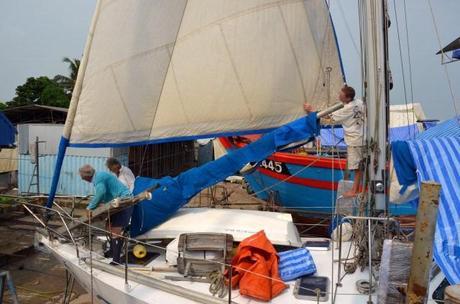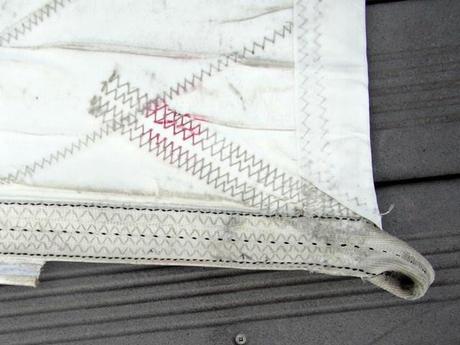 Cruisers flock towards the tropics, where all that sun exposure can be tough on sails. Short of alien ships on a bad landing approach, UV damage is the biggest culprit in ending the useful life of a sail. Jamie often checks sails on the boats we’re with, like Papa Djo next to us in the shipyard: in the last few months, a spate of them had no idea their sails suffered from moderate to severe damage.
Cruisers flock towards the tropics, where all that sun exposure can be tough on sails. Short of alien ships on a bad landing approach, UV damage is the biggest culprit in ending the useful life of a sail. Jamie often checks sails on the boats we’re with, like Papa Djo next to us in the shipyard: in the last few months, a spate of them had no idea their sails suffered from moderate to severe damage.
It’s not difficult for cruisers to inspect their own sails and have a good pulse on the condition, so compromised integrity doesn’t unexpectedly turn a nice day on the water into a mess. Jamie shares his perspective in this first of two posts on evaluating UV damage to sails.
Sailmaker says:
As with Totem’s resident gecko repairing its damaged tail (it fell off), it’s possible to revive sails from minor and even severe damage. With the right cloth, know how, and machine a (oops, didn’t see that squall) shredded sail can fly again with reconstructive surgery. Recutting a blown out sail is also possible. The nip and tuck of a skilled sailmaker can remove some sag and stretch of a well used sail. The bigger question for cruising sailors is: is it worth it?
I’m all for extending the life of cruising sails and anyone that seen Totem’s current headsail can attest to that! Still, as frugal as cruisers tend to be, there comes a time when the underlying structure of a sail begins failing. The culprit is usually damage from the sun. Just as UV rays can cause skin cancer, it also can rob strength from the strongest sailcloth and thickest thread. No fixed exposure time signifies when a sail becomes a rag. Sailcloth, thread, and protective materials degrade at different rates. So every time “the bloody sun, at noon” beats down upon the sails, a clock ticks time away from their lifespan.
Checking the Derm
First, step back and look at the big picture of the sail in question. Just as sailors should check their skin for potential UV related problems (especially old farts, defined by my children as anyone over 40) they should also check sails for UV damage. It easy enough to do and like many cancers, early diagnosis goes a long way toward mitigating the problem. Stitching or sailcloth with some UV damage is repairable. A sail weakened by UV damage and flogged while reefing or tacking can quickly become a shredded mess. Shredded sails are much harder to fix. With inspection you can also get a good sense of when UV damage is bad enough that repairs are a waste of money. Fixing one failed seam may not make sense if pervasive rotted thread means all the other seams are on the edge of failure.

Stitching
Testing stitching is simple: just scrape a thumbnail across stitching in various areas of the sail. You have to put some force into it! Look for two things:
- Do the stitches break? Bad news, the thread is toast.
- Do the stitches fray? Rotting: the more fraying you have, the more damaged it is.
Location matters. Stitching on the protective UV strip along a leech and foot is the first to go. Second is the mainsail leech area, because after dropping the main, the cover doesn’t always go on right away – does it? Test stitching on webbing reinforcement, seams, leech tapes, and batten pockets. You can also use this test for thread on dodger, bimini, leecloth, and mainsail covers, etc.
Stitching is the weakest part of any sail. Most sails and covers are sewn with UV stabilized Polyester (Dacron) thread, of varying thicknesses. In the tropics, two years of UV exposure on “UV stabilized” thread degrades strength by about 50%. That’s not a lab test figure, but drawn much experience. Higher latitudes may not have the same UV intensity (with exceptions like the ozone layer hole over New Zealand), but longer hours of sun in summer don’t help.
There’s a relatively new and supremely awesome thread that is little affected by UV: it’s PTFE (Teflon) thread. Tenara is a brand of PTFE thread made by Gore that sailmakers will know by name. PTFE thread is a little weaker than Polyester when both are new, though not so much as to compromise a sail. After time in the sun, PTFE retains its original strength while Polyester weakens significantly. PTFE thread is also very slippery, so I suspect a little more chafe resistant. Some sailmakers shy away from PTFE thread because is it more expensive and harder work with (read: a royal pain for sewers). Still, it’s a must-use on UV strips, mainsail and exterior canvas or covers. Long term tropical sailors should also consider PTFE thread for seams as well. It should only adds about 3% to the price.
This covers stitching; Part II will address sailcloth. And of course, if that sail is beyond salvaging, Jamie is an active sailmaker and would love to provide a quote for a new sail! And whether you are interested in a new sail from him or not, he’s happy to just answer questions to try and combat the reams of misinformation he sees online about sails.
Coming soon- Part II: evaluating sailcloth. Savvy sailors know we love it when you read this on the Sailfeed website.

